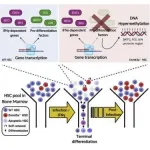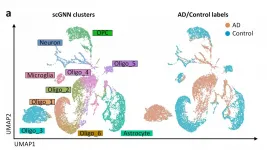Study reveals how long-term infection and inflammation impairs immune response as we age
2021-03-25
(Press-News.org) HOUSTON, TX - March 25, 2021 - Humans are born with tens of thousands of hematopoietic stem cells (HSCs) that collectively ensure lifelong production of blood and immune cells that protect us from infections. HSCs can either duplicate to produce more stem cell progeny or differentiate to produce distinct immune cell lineages, an extremely critical decision that ensures that the body achieves the fine balance between having enough immune cells to fight invaders while still retaining enough HSCs to maintain future blood production. As we age, HSCs accumulate mutations that lead to the emergence of genetically distinct subpopulations. This common phenomenon known as clonal hematopoiesis (CH) is known to start in early fifties and is frequently associated with loss of function mutations in the DNMT3A gene. CH is associated with a significantly higher risk of blood cancers, cardiovascular disease, stroke and all-cause mortality.
A study led by Dr. Katherine King, associate professor at Baylor College of Medicine and Texas Children's Hospital, shows for the first time that long-term infection and chronic inflammation drive CH mediated by the loss of Dnmt3a function. In addition, the study offers key insights into the mechanism by which chronic inflammation leads to CH and demonstrates the critical role of DNMT3a in regulating normal HSC responses to infections. The study was published in the journal Cell Stem Cell.
"Previously, we showed that chronic infection significantly impairs the ability of wild-type HSCs to remain in a quiescent stem cell state. Prolonged (lasting several months) exposure to a systemic bacterial infection promoted extensive differentiation of HSCs. While this produced sufficient immune cells to fight the infection, it also reduced the number of bone marrow HSCs by 90%," King said. "In contrast, HSCs in mice lacking Dnmt3a gene did not differentiate much. In fact, they underwent self-renewal to produce more HSCs. We undertook the current study to test our prediction that defective differentiation and increased duplication of Dnmt3a HSCs allows them to overtake and outcompete normal HSCs when fighting chronic infections or facing long-term inflammatory conditions."
To test their hypothesis, researchers used a combination of experimental and mathematical modeling experiments to test how HSCs from Dnmt3a mutant mice respond to long-term infection and chronic inflammation. For experimental validation, they generated mosaic mice that were generated by transplanting a mixture of whole bone marrow from Dnmt3a-mutant mice and normal mice into irradiated mice, which allowed them to track how each subpopulation of HSC contracts or grows relative to one another over time when infected for several months with Mycobacterium avium bacteria.
Using this model that mimics chronic infection in humans, they found long-term infection caused specific expansion of Dnmt3a-loss of function HSCs along with a concomitant reduction in their ability to differentiate into immune cells, which is contrary to the behavior exhibited by normal HSCs to chronic infection. Moreover, compared to the normal HSCs, Dnmt3a HSCs were more resistant to exhaustion and were less sensitive to stress-induced apoptosis ('cell death') upon chronic infection. Collectively, this indicates how a minor population of Dnmt3a HSCs could eventually overtake a major population of normal HSCs in the presence of chronic infection.
A number of viral or bacterial infections and chronic inflammatory stress conditions including tuberculosis, hepatitis, herpetic infections, and inflammatory bowel disease trigger the release of interferon gamma (IFNγ) by the immune system, which in turn, initiates a cascade of protective immune responses. The team found that compared to wild-type HSCs, Dnmt3a-loss of function HSCs exhibited an entirely opposite set of cellular responses and global changes in gene expression patterns in response to IFNγ, which tended towards preserving or even increasing the numbers of stem cells at the expense of mounting an effective response against imminent invaders or stress.
"We are excited by the findings of this study which opens several areas of future investigations. We have shown for the first time how chronic inflammation due to long-term infections or autoimmune conditions such as rheumatoid arthritis, ulcerative colitis or Crohn's disease dampen the body's immune response as we age. Moreover, it sheds light on the critically important role of DNMT3a in modulating immune responses during chronic infection or stress and also explains how aging and inflammation are linked to blood cancers," King concluded.
INFORMATION:
Other authors involved in the study are Daniel Hormaechea-Agulla, Katie Matatall, Duy Le, Grant Challen, and Marek Kimmel. They are affiliated with one or more institutions: Baylor College of Medicine, Rice University, Silesian University of Technology, and Washington University School of Medicine. Grants from the National Institutes of Health, Dan L. Duncan Cancer Center, and Polish National Science Center supported this work.
[Attachments] See images for this press release:

ELSE PRESS RELEASES FROM THIS DATE:
2021-03-25
More than 150 years ago, the Sun blasted Earth with a massive cloud of hot charged particles. This plasma blob generated a magnetic storm on Earth that caused sparks to leap out of telegraph equipment and even started a few fires. Now called the Carrington Event, after one of the astronomers who observed it, a magnetic storm like this could happen again anytime, only now it would affect more than telegraphs: It could damage or cause outages in wireless phone networks, GPS systems, electrical grids powering life-saving medical equipment and more.
Sun-facing satellites monitor the Sun's ultraviolet (UV) light to give us advance warning of solar storms, both big ones that could cause a Carrington-like ...
2021-03-25
NEW YORK, NY--Treatments for a rare retinal disease may be on the horizon after a new study has identified gene variants that cause a metabolic deficiency in the eye.
The disease, macular telangiectasia type 2 (MacTel), has been a research focus of Rando Allikmets, PhD, a pioneer in the genetics of eye diseases, for nearly 15 years. MacTel occurs in approximately 1 in 5,000 adults over age 40 and slowly causes a significant loss of central vision, which can impair driving, reading, and other activities.
"MacTel is clearly a genetic disease because it tends to run in families, but it's been a tough nut to crack," says Allikmets, the William and Donna Acquavella Professor of Ophthalmic Sciences ...
2021-03-25
TAMPA, Fla. -- Chimeric antigen receptor T-cell therapy, or CAR T, is a relatively new type of therapy approved to treat several types of aggressive B cell leukemias and lymphomas. Many patients have strong responses to CAR T; however, some have only a short response and develop disease progression quickly. Unfortunately, it is not completely understood why these patients have progression. In an article published in Proceedings of the Royal Society B, Moffitt Cancer Center researchers use mathematical modeling to help explain why CAR T cells work in some patients and not in others.
CAR T is a type of personalized immunotherapy that uses a patient's own T ...
2021-03-25
ORLANDO, March 25, 2021 - Early screening can mean the difference between life and death in a cancer and disease diagnosis. That's why University of Central Florida researchers are working to develop a new screening technique that's more than 300 times as effective at detecting a biomarker for diseases like cancer than current methods.
The technique, which was detailed recently in the Journal of the American Chemical Society, uses nanoparticles with nickel-rich cores and platinum-rich shells to increase the sensitivity of an enzyme-linked immunosorbent assay (ELISA).
ELISA is a test ...
2021-03-25
Studying genetic material on a cellular level, such as single-cell RNA-sequencing, can provide scientists with a detailed, high-resolution view of biological processes at work. This level of detail helps scientists determine the health of tissues and organs, and better understand the development of diseases such as Alzheimer's that impacts millions of people. However, a lot of data is also generated, and leads to the need for an efficient, easy-to-use way to analyze it.
Now, a team of engineers and scientists from the University of Missouri and the Ohio State University have created a new way to analyze data from single-cell RNA-sequencing ...
2021-03-25
The very first moments of the Universe can be reconstructed mathematically even though they cannot be observed directly. Physicists from the Universities of Göttingen and Auckland (New Zealand) have greatly improved the ability of complex computer simulations to describe this early epoch. They discovered that a complex network of structures can form in the first trillionth of a second after the Big Bang. The behaviour of these objects mimics the distribution of galaxies in today's Universe. In contrast to today, however, these primordial structures are microscopically small. Typical clumps have masses of only a few grams and fit into volumes much smaller than present-day elementary particles. The results of the study have been published ...
2021-03-25
One-third of the Earth's surface is covered by more than 11,000 grass species -- including crops like wheat, corn, rice and sugar cane that account for the bulk of the world's agricultural food production and important biofuels. But grass is so common that few people realize how diverse and important it really is.
Research published today in the journal Nature provides insights that scientists could use not only to improve crop design but also to more accurately model the effects of climate change. It also offers new clues that could help scientists use ...
2021-03-25
Orthopaedic researchers are one step closer to preventing life-long arm and leg deformities from childhood fractures that do not heal properly.
A new study led by the University of South Australia and published in the journal Bone, sheds light on the role that a protein plays in this process.
Lead author Dr Michelle Su says that because children's bones are still growing, an injury to the growth plate can lead to a limb in a shortened position, compared to the unaffected side.
"Cartilage tissue near the ends of long bones is known as the growth plate that is responsible for bone growth in children and, unfortunately, 30 per cent of childhood and teen fractures involve this growth ...
2021-03-25
Researchers have used the evidence of pumice from an underwater volcanic eruption to answer a long-standing mystery about a mass death of migrating seabirds.
New research into the mass death of millions of shearwater birds in 2013 suggests seabirds are eating non-food materials including floating pumice stones, because they are starving, potentially indicating broader health issues for the marine ecosystem.
The research which was led by CSIRO, Australia's national science agency, and QUT, was published in the journal Marine Ecology Progress Series, that examined a 2013 seabird "wreck" in which up to 3 million ...
2021-03-25
A coordinated global effort to reduce the production of greenhouse gas emissions from industry and other sectors may not stop climate change, but Earth has a powerful ally that humans might partner with to achieve carbon neutrality: Mother Nature. An international team of researchers called for the use of natural climate solutions to help "cancel" produced emissions and remove existing emissions as part of a comprehensive plan to keep global warming below 1.5 degrees Celsius -- the point at which damage to human life and livelihoods could become catastrophic, according to the United Nations' Intergovernmental Panel on Climate Change.
The researchers published their invited views on March 24 in ...
LAST 30 PRESS RELEASES:
[Press-News.org] Study reveals how long-term infection and inflammation impairs immune response as we age






